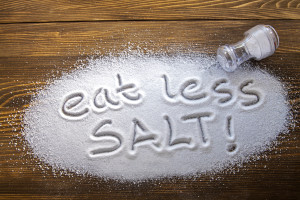5 Tips to Lowering your Salt Intake
by guest blogger DaVita dietitian Susan Zogheib, MHS, RD, LDN

Salt is made up of 40 percent sodium and 60 percent chloride and is very important to your life. You can’t live without it because salt serves many functions. It helps to maintain blood’s water content, balances the acids and bases in your blood, and helps to keep the nerves and muscles working smoothly. But too much salt can be very dangerous.
Excessive amount of sodium in the diet can lead to high blood pressure. High blood pressure is a leading cause of kidney disease in the United States. High blood pressure increases your risk of developing a heart attack or stroke. Unfortunately, there is no cure; however, it can be better controlled and managed with medications, diet and exercise.
One way to reduce your blood pressure is to reduce the amount of salt you consume. It’s important to reduce your sodium intake by cutting down on foods with high sodium content. The National Kidney Foundation recommends that those with high blood pressure or kidney disease limit daily sodium intake to 2,000 milligrams (mg). To put it in perspective, a teaspoon of salt contains about 2,400 mg of sodium, so 2,000 mg can add up quickly.
Here are five tips to follow to help you lower your salt intake:
- Cut down on luncheon meats: Use fresh poultry, fish, and lean meat, rather than canned or processed deli meats. Typically a sodium-phosphate solution is injected into the processed deli meats, making them high in sodium. Two slices of regular ham contain 604mg sodium, almost half the daily recommended limit.
- Cook it up. Prepare your own food when you can. Don’t salt foods before or during cooking, and limit salt shaker use at the table. Use fresh garlic, fresh onion, garlic powder, onion powder, black pepper, or lemon juice to spice up your cooking.
- Get fresh. Buy fresh or frozen (not processed) poultry, pork and lean meat rather than canned, smoked or processed meats like sausages, corned beef and luncheon meats. Fresh foods generally have less sodium.
- Drain and rinse. Draining and rinsing canned goods that contain salt helps to reduce the amount of sodium. Try this method with your canned beans, vegetables, and tuna before using the next time.
- Scratch the condiments. Soy sauce, ketchup, salad dressings, and seasoning packets tend to have a lot of sodium in them and your daily allowance can certainly add up quickly. Choose lite or reduced sodium soy sauce and no-salt-added ketchup. You can also add olive oil and balsamic vinegar to a salad rather than bottled salad dressings. You can also try this easy salt-free seasoning dip to use with your low-salt crackers, vegetables and snacks.
Additional Kidney Diet Resources
Visit DaVita.com and explore these diet and nutrition resources:
DaVita Kidney-Friendly Recipes
This article is for informational purposes only and is not a substitute for medical advice or treatment. Consult your physician and dietitian regarding your specific diagnosis, treatment, diet and health questions.

Recent Comments